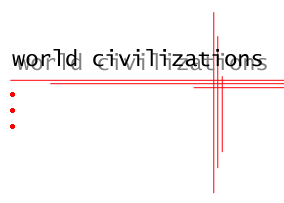JOHN TOLAND HITLER BOOK WITH OBSCURE PAINTING
August 14, 2007 at 6:50 am | Posted in Art, Books, Germany, History | Leave a commentIn the Beginning was the Word (Am Anfang war das Wort)
- A painting titled by Hermann Otto Hoyer depicts the glorification of Hitler in messiah-like fashion.
- The light over him falls on the listener. Hitler represents the bringer of light.
- “In the Beginning was the Word” of course appears as the first words in the Gospel of John.
(Source: The Visualisation Of National Socialist Ideology)
This painting appears as a tiny photo-illustration in John Toland’s 1976 book classic, “Adolf Hitler.”
| Hermann O. Hoyer painting: “In the Beginning Was the Word” |
| Hitler’s Theological Language |
| The modern viewer observes the Hermann O. Hoyer painting, “In the Beginning Was the Word” with nothing less than shock. What is so shocking about a dark picture that represents a man speaking to a small, attentive audience in a Gasthaus? Perhaps the image of Adolf Hitler, dressed in benign civilian attire as he addresses a diverse gathering of Germans, conveys a specific blasphemy. The title of the artwork, after all, alludes to the opening verse of John’s Gospel. Perhaps the direct parallel of Hitler’s arms, bent in mirror image of the Nazi swastika on the flag which hangs directly behind him, conveys a subtle image of the crucified Christ. Maybe it is the transfixed attention of the listeners who are enlightened, both literally by the only ambient light depicted in the painting, and symbolically, by the message of the speaker from whom the light seems to issue.Since the painting was made in depression era Germany, the contemporary viewer would immediately, even unconsciously, infuse a lifetime of learned Christian symbolism to the rendering. Here was the savior bearing a message of hope in those dark days of inflation, unemployment, and social chaos. He was the new Messiah, this Adolf Hitler. The artist wanted to show that Hitler was the redeemer of fallen Germany, the savior who would liberate them from the evil Versailles Treaty brought about by the lies and betrayals of the satanic Jews, none of whom is visible in this picture. Indeed, the mysterious origin of the painting’s light over the listeners suggests Pentecost. That is the moment traditionally portrayed by symbolic ‘flames of enlightenment’, as if to show the truth of Christ shining on the apostles, who then went forth to spread the word. The painting’s listeners would be so enlightened and spread Hitler’s new truth. The Nazi genius for propaganda allowed them to shamelessly usurp for their own ends symbols and terminology found in the Jewish and Christian writings of Tanak and New Testament. These symbols and words were ingrained in a German population through years of religious instruction, literary usage, and social convention. Even a secular German could not escape a language suffused with originally religious terminology.Adolf Hitler saw the world with a distinctly ‘religious’ viewpoint. That is to say his worldview was clearly bound up in a fall from grace, resurrection, and victory schematic. He specifically introduced this idea in Mein Kampf, and restated it in virtually every public utterance thereafter. So it was that Hitler applied one of the lessons he learned best in the trenches of Belgium: propaganda. He would co-opt the strengths of his enemies to his own ends.
Religious language suffused the Third Reich. They Nazis turned the benign concepts about God to their own ends by subtle means. They were wolves in sheep’s clothing. |
Mit Brennender Sorge, Pius XI, Encyclical, 1937
This distortion was exposed by the 1937 Vatican Encyclical, Mit Brennender Sorge, (With Burning Anxiety), uniquely published originally in the German language. It excoriated the consistent Nazi dismantling of the Concordat between Rome and Berlin. Not only had the Nazis broken virtually every component, among which were provisions for religious education, public practice of religion, and social activities, it had even begun to subvert the truths behind the language of the Christian religion.
Beware, Venerable Brethren, of that growing abuse, in speech as in writing, of the name of God as though it were a meaningless label, to be affixed to any creation, more or less arbitrary, of human speculation…Our God is the Personal God, supernatural,…who will not, and cannot, tolerate a rival God by His side.
Mit Brennender Sorge, Pius XI, Encyclical, 1937
The poison spread not only throughout Germany, but to Germans in America as well. The faux religion of Nazism, or at least the apparent acceptance of religion by the Hitler state, deceived millions. For example, by substituting apparently wholesome Hitler Youth activities for Confirmation ceremonies, or inserting Nazi themes into apparent prayers, or even creating National ceremonies to replace religious rituals, the cultural religiosity of the country was co-opted and believers duped into slowly accepting Nazi beliefs.
In night’s darkest hour every November 9th, to commemorate the Nazi coup d’etat of 1923, a mystical midnight oath-taking ceremony took place in a sacred hall under the eyes of Adolf Hitler. There the SS, Hitler’s special troops, took an oath of personal loyalty to him. One remembers, ” Splendid young men, serious of face, exemplary of bearing and turnout. An elite. Tears came to my eyes when, by the light of the torches, thousands of Voices repeated the oath in chorus. It was like a prayer.”
During their rise to power, the Nazis usurped virtually all traditions, symbols, and words of pious German Christianity. Indeed, the most egregious was to call Adolf Hitler the Savior. Perhaps this extract from the SS catechism characterizes this subtle transference best: The question, ‘Whom must we primarily serve?’ required the response, ‘The people and our Fuhrer, Adolf Hitler’. ‘Why do we believe in Germany and the Fuhrer?’ ‘ Because we believe in God,…and in the Fuhrer, Adolf Hitler, whom He has sent us.”








